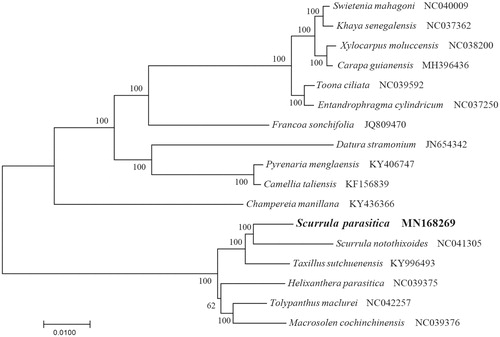Abstract
Scurrula parasitica Linn. is a hemiparasitic shrub distributed in southern China and Southeast Asian countries. Here, we report and characterize the complete plastid genome sequence of S. parasitica in an effort to provide genomic resources useful for the phylogenetic studies for Santalales. The complete chloroplast genome of S. parasitica was 122,599 bp in total sequence length, which containing two inverted repeats (IRs) of 23,137 bp separated by a large single-copy (LSC) and a small single copy (SSC) of 70,237 bp and 6,088 bp, respectively. The cpDNA contains 105 genes, comprising 67 protein-coding genes, 30 tRNA genes, 8 rRNA genes. The overall GC content of the plastome is 37.2%. Phylogenetic analysis with 17 species revealed that S. parasitica was closely related to the congeneric species S. notothixoides.
Scurrula parasitica Linn., belonging to family Loranthaceae, is mainly distributed in tropical countries such as Vietnam, Laos, Cambodia, Thailand, Indonesia, and Philippines, as well as in south and southwest China. Recorded hosts for this species include Citrus aurantium, Cordia dichotoma, Euodia lepta, Hibiscus tiliaceus, Melastoma sp (Qiu and Gilbert Citation2003). S. parasitica is wildly used in various traditional Chinese medicine prescriptions. The Chinese Pharmacopoeia records it as a medicinal material with wind-dispelling and dampness removal effects; it nourishes the liver and kidneys, strengthens the tendons and muscles, and prevents miscarriage (Liu et al. Citation2019). Here, we report and characterize the complete plastome of S. parasitica based on Illumina paired-end sequencing data, which will contribute to the further studies on its genetic research and resource utilization. The annotated cp genome of S. parasitica has been deposited into GenBank with the accession number MN168269.
In this study, S. parasitica was sampled from in Jiangxi province of China, located at 114°20′32.04″E, 25°20′25.57″N. A voucher specimen (Y.-C. Shi et al. S205) was deposited in the Guangxi Key Laboratory of Plant Conservation and Restoration Ecology in Karst Terrain, Guangxi Institute of Botany, Guangxi Zhuang Autonomous Region and Chinese Academy of Sciences, Guilin, China. The experiment procedure is as reported in Zhang et al. (Citation2019). Around 2 Gb clean data were used for the cp genome de novo assembly by the program NOVOPlasty (Dierckxsens et al. Citation2017) and direct-viewing in Geneious R11 (Biomatters Ltd., Auckland, New Zealand). Annotation was performed with the program Plann (Huang and Cronk Citation2015) and Sequin (http://www.ncbi.nlm.nih.gov/).
The plastome of S. parasitica was found to possess a total length 122,599 bp with the typical quadripartite structure of angiosperms, containing two inverted repeats (IRs) of 23,137 bp separated by a large single-copy (LSC) and a small single copy (SSC) of 70,237 bp and 6,088 bp, respectively. The cpDNA contains 105 genes, comprising 67 protein-coding genes, 30 tRNA genes, 8 rRNA genes. Among the annotated genes, 7 of them contain one intron (rpl16, atpF, rpoC1, trnL-UAA, petB, petD and rpl2), and three genes (rps12, ycf3, and clpP) contain two introns. The overall GC content of the plastome is 37.2%, which is unevenly distributed across the whole chloroplast genome.
To identify the phylogenetic position of S. parasitica, phylogenetic analysis was conducted. A neighbor joining (NJ) tree with 1000 bootstrap replicates was inferred using MEGA version 7 (Kumar et al. Citation2016) from alignments created by the MAFFT (Katoh and Standley Citation2013) using plastid genomes of 17 species. It showed the position of S. parasitica was closely related to the congeneric species S. notothixoides (). Our findings will provide a foundation for facilitating its genetic research and contributing to its utilization in Scurrula.
Disclosure statement
No potential conflict of interest was reported by the authors.
Additional information
Funding
References
- Dierckxsens N, Mardulyn P, Smits G. 2017. NOVOPlasty: de novo assembly of organelle genomes from whole genome data. Nucleic Acids Res. 45(4):e18.
- Huang DI, Cronk Q. 2015. Plann: a command-line application for annotating plastome sequences. Appl Plant Sci. 3(8):1500026.
- Katoh K, Standley DM. 2013. MAFFT multiple sequence alignment software version 7: improvements in performance and usability. Mol Biol Evol. 30(4):772–780.
- Kumar S, Stecher G, Tamura K. 2016. MEGA7: molecular evolutionary genetics analysis Version 7.0 for bigger datasets. Mol Biol Evol. 33(7):1870–1874.
- Liu RY, Su BW, Huang FY, Ru M, Zhang H, Qin ZM, Li YH, Zhu KX. 2019. Identification and analysis of cardiac glycosides in Loranthaceae parasites Taxillus chinensis (DC.) Danser and Scurrula parasitica Linn. and their host Nerium indicum Mill. J Pharm Biomed Anal. 174:450–459.
- Qiu HX, Gilbert MG. 2003. Flora of China. Beijing: Olacaceae. Science Press and the Missouri Botanical Garden Press.
- Zhang Y, Shi YC, Duan N, Liu BB, Mi J. 2019. Complete chloroplast genome of Euphorbia tirucalli (Euphorbiaceae), a potential biofuel plant. Mitochondrial DNA Part B. 4(1):1973–1974.

